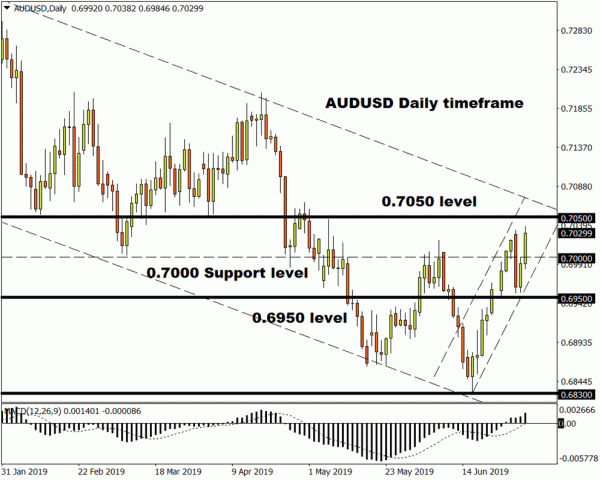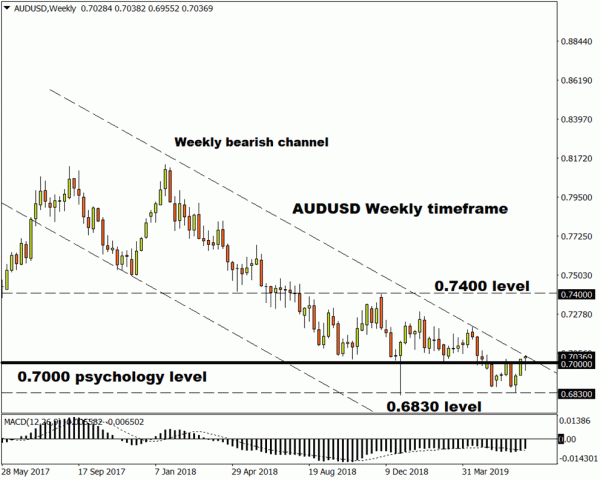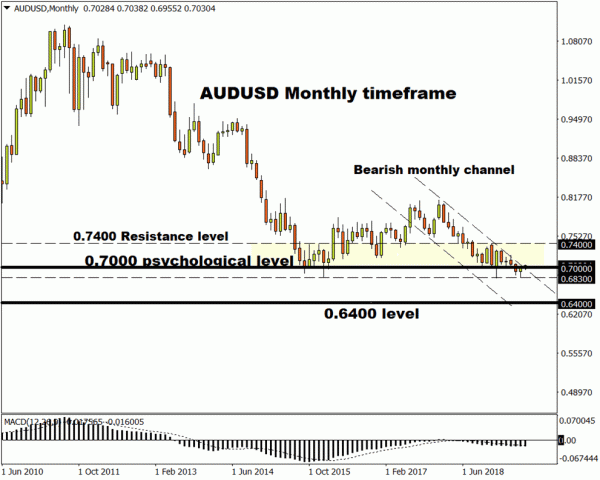The Australian Dollar’s bearish trend that began in early 2018 is set to extend into the current quarter.
The Reserve Bank of Australia has come a long way from earlier in the year when it painted a picture of steady growth for the domestic economy. The central bank then proceeded to lower its cash rate target by 25 basis points in June, before cutting rates by a similar margin again at the start of July. As worries increase about weaker economic conditions, Australia’s benchmark interest rate has reached a new record low of one percent. Those cuts were heavily anticipated by investors, sending the Aussie down over one percent against the greenback in Q2, erasing gains from the first quarter to register an overall decline of 0.4 percent for the first half of 2019.
Fed rate cut could offer limited relief for AUD
Later this month, it could be the Federal Reserve’s turn. Investors will turn their attention to the scheduled FOMC meeting at the end of July to see if Fed chair Jerome Powell and his colleagues join the easing party. At the time of writing, Fed Funds futures point to a 100 percent chance of a US rate cut this month. Although a Fed rate cut has been largely priced in, the actual event could still offer some limited relief for the Australian Dollar and nudge it towards the 0.7 mark against its US counterpart.
US-China tensions to continue holding sway over AUD performance
Another theme that’ll continue to drive the Australian Dollar’s performance is US-China trade tensions, given that Australia’s dependence on the Chinese economy is the highest compared to other developed nations. According to the Australian Department of Foreign Affairs and Trade, China accounted for 34 percent of Australia’s total goods exports in 2018.
Yet the recently announced truce between US President Donald Trump and Chinese President Xi Jinping wasn’t enough for the AUDUSD to break above its 100-day moving-average of 0.7035. Revived US-China trade talks merely delay the risk of more tariffs being imposed, without completely nullifying the threat. Keep in mind the tariffs that have already been implemented on US-China trade remain in place. The heightened tensions are clearly dampening global growth. For proof, look no further than Asia’s exports slump, Europe’s sluggish manufacturing sector and declining PMI figures around the world. Given Australia’s outward-facing economy, AUD’s appeal has been muted.
Australia’s uninspiring economic outlook to weigh on AUD
Australia is certainly not immue to the downside external risks, with exports and investments having been curtailed by concerns over global trade tensions. First quarter GDP of 1.8 percent was its lowest since 2009, while inflation has stubbornly failed to live up to the RBA’s target range of 2-3 percent. Falling house prices have dampened consumer sentiment, and Australia’s unemployment rate remains above five percent.
The gloomy economic indicators only serve to dampen sentiment surrounding AUD, until at least the fiscal stimulus cavalry comes to the aid of the domestic economy, while the lowered cash rate finds its way into consumers’ pockets. The prospects of more government spending, coupled with potential gains in commodity prices, could offer underlying support for the Australian Dollar in the third quarter. However, whether AUD can take advantage of such tailwinds is contingent on the global demand outlook not deteriorating any further due to a rapid escalation in US-China trade tensions.
AUDUSD bearish trend to remain intact in Q3
From a technical perspective, the currency pair’s moving averages have acted as stubborn resistance levels, leaving AUDUSD with a path-of-least-resistance to the downside. Hence, the Australian Dollar is expected to remain below the 0.7 psychological level for most of Q3.















